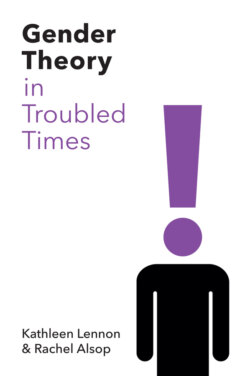Читать книгу Gender Theory in Troubled Times - Rachel Alsop - Страница 28
Notes
Оглавление1 See the discussion in Gatens (1996). One of the important influences on first making the distinction was the work of Robert Stoller (1968), who paid attention to both transvestite and transsexual people. For Stoller, ‘a person’s gender identity is primarily a result of … [social] influences. These … can completely override the biological fact of a person’s sex and result in, for example, the situation of the transsexual [person]’ (Gatens 1996: 6). Nonetheless, it is not clear that the distinction is adequate to capture the very diverse experiences of trans people, a point we will return to later in this book. 2 The scientific scepticism of ‘binary’ sex – that is, the idea that there are men and women and that they can be clearly distinguished – started even earlier. In 1968 the Journal of the American Medical Association carried an article by the biologist Keith L. Moore listing nine different components of someone’s sexual identity: external genital appearance, internal reproductive organs, structure of the gonads, endocrinologic sex, genetic sex, nuclear sex, chromosomal sex, psychological sex and social sex. See also Heggie (2015). 3 Intersex Society of North America: www.isna.org/node/523. 4 There is clearly a question as to why this is, and some argue that, though women do not perform to such high levels as men, this is because of a history of exclusion and that, theoretically at least, as women and men’s achievements begin to converge, they could in time equal out. 5 The reporting of this matter has been marred by an ugly sexism and racism. Castor is claimed to look masculine, on a standard of looks which privileges a certain kind of white femininity and echoes what Lugones (2010) calls the colonial logic of gender and race. Similar problems have beset the reporting of the achievements of other black female athletes, such as the tennis player Serena Williams and gymnast Gabby Douglas. 6 These writings have been called ‘new materialism’ to distinguish them from both reductive materialism, which sees scientific facts as determining culture, and Marxist historical materialism, which will be the focus of chapter 3. 7 There is some slippage in these discussions between biology conceived as biological facts and biology as a science. We take it that the concern is that our accounts of everyday sexed difference reflect the facts of biology, whatever these may be, and that an engagement with biology as a science is required to provide the best articulation of those facts. 8 Grosz quotes approvingly from Darwin: ‘We have thus far been baffled in all our attempts to account for the differences between the races of man; but there remains one important agency, namely Sexual Selection. … It can further be shewn that the differences between the races of man, as in colour … &c., … might have been expected [from] … sexual selection’ (Grosz 2008: 35). 9 This need is, of course, currently being undermined with the development of cloning.
